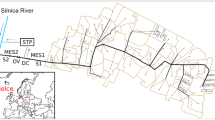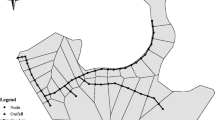Abstract
Rainfall-derived infiltration and inflow (RDII) is extraneous water in a sanitary sewer system that originates from surface runoff. Most RDII enters sanitary sewer systems through illegal connections or mechanical faults, especially in aged sewer systems. In this study, the physical process of three primary RDII sources: roof downspout, sump pump, and leaky lateral, are investigated using physics-based models. These three sources represent three different flow paths: direct connection of impervious catchments, mixed flow through coarse porous media followed by a direct connection, and percolated flow through compacted soil. Due to the differences in medium and the lengths of flow paths, flow responses of these three RDII sources differ in time and magnitude. In turn, they can be distinctly identified from each other. The typical flow response of each RDII source is represented as an impulse response function (IRF), a flow response to a pre-specified representative rainfall computed using physics-based models. The total RDII flow hydrograph is presented as a combination of these three IRFs. The weighting factors of each IRF are calculated using a genetic algorithm technique in a test sewer basin in a suburb of Chicago, IL. The model results suggest leaky lateral might be the biggest RDII contributor to the system. The model performance was compared with one of the more widely used RDII estimation methods, the Storm Water Management Model RTK method. While the RTK method shows better performance overall, the IRF method provides a unique solution with robust performance. The suggested physics-based approach may shed light on identifying local RDII issues with more detail, facilitating more effective management of a sewer system.




Similar content being viewed by others
References
Allitt R (2002) Rainfall, runoff and infiltration re-visited. WaPUG Spring Meeting 2002:1–9
Beheshti M, Sægrov S (2018) Quantification assessment of extraneous water infiltration and inflow by analysis of the thermal behavior of the sewer network. Water 10(8):1070. https://doi.org/10.3390/w10081070
Bhaskar AS, Welty C (2012) Water balances along an urban-to-rural gradient of metropolitan Baltimore, 2001–2009. Environ Eng Geosci 18(1):37–50
Bishop WJ, Diemer DM, Wallis MJ (1987) Regional infiltration/inflow study solves wet weather sewer problems. J Water Pollut Control Fed 59(5):289–293. http://www.jstor.org/stable/25043247?origin=JSTOR-pdf
Camp Dresser and McKee (CDM) Inc., F.E. Jordan Associates Inc., James M. Montgomery Consulting Engineers (1985) East Bay infiltration/inflow study manual for cost-effectiveness analysis: Oakland, CA: East Bay Municipal Utility District (EBMUD)
Carlier JP, Kao C, Ginzburg I (2007) Field-scale modeling of subsurface tile-drained soils using an equivalent-medium approach. J Hydrol 341(1–2):105–115. https://doi.org/10.1016/j.jhydrol.2007.05.006
Choi NJ (2016) Understanding sewer infiltration and inflow using impulse response functions derived from physics-based models (Doctoral Dissertation), University of Illinois at Urbana-Champaign. https://www.ideals.illinois.edu/items/92891
Chow VT (1959) Open-channel hydraulics. McGraw-Hill. p 680
Chow VT, Maidment DR, Mays LW (1988) Applied hydrology. McGraw-Hill, New York
Crawford D, Eckley P, Pier E (1999) Methods for estimating inflow and infiltration into sanitary sewers. New applications in modeling urban water systems, Volume 7, Conference on Stormwater and Related Water Systems Modeling; Management and Impacts. Toronto: CHI, pp 299–315
DHI Software (2007a) MIKE SHE user manual volume 1: User guide (Vol. 1)
DHI Software (2007b) MIKE SHE user manual volume 2: Reference guide (Vol. 2)
Ertl TW, Dlauhy F, Haberl R (2002) Investigations of the amount of infiltration/inflow into a sewage system. In Proceedings of the 3rd Sewer Processes and Networks International Conference. Paris, France
Espey WH Jr, Clemmens B, Halverson B (2014) Lake Michigan Diversion Committee: Findings of the seventh technical committee for review of diversion flow measurements and accounting procedures. Chicago, p 124
Graham DN, Butts MB (2005) Flexible integrated watershed modeling with MIKE SHE. In: Singh VP, Frevert DK (eds) Watershed Models. CRC Press, pp 245–272
Grimmond C, Oke T (1999) Evapotranspiration rates in urban areas: In impacts of urban growth on surface water and groundwater quality. In Proceedings of International Union of Geodesy and Geophysics 1999 Symposium HS5. Birmingham, UK, pp 235–243
Hodgson JE, Ward CJ, Schultz NU (1995) Sanitary sewage discharges in the city of Edmonton, Alberta, 1995. In seminar publication: National Conference on Sanitary Sewer Overflows (SSOs) in April 24–26, 1995. Washington, D.C., pp 403–413
Hydrocomp (1979) Chicago sanitary and ship canal hydrologic calibration, report to the Northeastern Illinois Planning Commission. IL, Areawide Clean Water Planning, Water Quality Evaluation, Chicago
Illinois State Water Survey (2019) Cook County precipitation network: Data collection, data provided by the Illinois State Water Survey (ISWS) located in Champaign and Peoria, Illinois. https://www.isws.illinois.edu/data/ccprecipnet/livedata.asp. Accessed 20 Jul 2021
Kretschmer F, Ertl T, Koch F (2008) Discharge monitoring and determination of infiltration water in sewer systems. In 11th International Conference on Urban Drainage. pp 1–7. Edinburgh, Scotland, UK
Lai FD (2008) Review of sewer design criteria and RDII prediction methods. EPA, Washington, D.C.
Miller K, Schmidt AR (2010) Hydraulic modeling of the Calumet interceptor network, Tunnel and Reservoir Plan, Report No. 10. Urbana, IL: University of Illinois at Urbana-Champaign
Nash JE, Sutcliffe JV (1970) River flow forecasting through conceptual models, Part I - a discussion of principles. J Hydrol 10:282–290
National Small Flows Clearinghouse (1999) Infiltration and inflow can be costly for communities. Pipeline: Small Community Wastewater Issues Explained to the Public, 10(2)
Natural Resources Conservation Service (2019) U.S. General Soil Map (STATSGO2), United States Department of Agriculture. https://sdmdataaccess.sc.egov.usda.gov. Accessed 20 Jul 2021
Nogaj RJ, Hollenbeck AJ (1981) One technique for estimating inflow with surcharge conditions. J Water Pollut Control Fed 53(4):491–496
Panasiuk O, Hedström A, Langeveld J, Viklander M (2022) Identifying sources of infiltration and inflow in sanitary sewers in a northern community: Comparative assessment of selected methods. Water Sci Technol 86(1):1–16. https://doi.org/10.2166/wst.2022.151
Petroff RG (1996) An analysis of the root cause of sanitary sewer overflows. In Seminar Publication National Conference on Sanitary Sewer Overflows (SSOs): April 24–26, 1995. Washington D.C. Cincinnati, OH: EPA, pp 8–15
U.S. Census Bureau (2010) Profile of general population and housing characteristics: 2010 Demographic Profile Data (DP-1): Hickory Hills city, Illinois, American Factfinder. http://factfinder.census.gov/faces/tableservices/jsf/pages/productview.xhtml?src=bkmk. Accessed 20 Jul 2021
Vallabhaneni S, Chan CC, Burgess EH (2007) Computer tools for sanitary sewer system capacity analysis and planning. Cincinnati, OH
Van Genuchten MT (1980) A closed-form equation for predicting the hydraulic conductivity of unsaturated soils. Soil Sci Soc Am 44(5):892–898
Vogel T, Van Genuchten MT, Cislerova M (2000) Effect of the shape of the soil hydraulic functions near saturation on variably-saturated low predictions. Adv Water Resour 24:133–144
Walski TM, Barnard TE, Harold E, Merritt LB, Walker N, Whitman BE (2007) Wet weather wastewater flows. Wastewater collection system modeling and design (1st ed.). Bentley Institute Press, pp 203–270
Weiss G, Brombach H, Haller B (2002) Infiltration and inflow in combined sewer systems: long-term analysis. Water Sci Technol 45(7):11–19. http://www.ncbi.nlm.nih.gov/pubmed/11989885
Wright L, Dent S, Mosley C, Kadota P, Djebbar Y (2001) Comparing rainfall dependent inflow and infiltration simulation methods. In W. James (Ed.), Models and Applications to Urban Water Systems. Monograph 9. Ontario, Canada: CHI, pp 235–257
Acknowledgements
This research was supported by the Tunnel and Reservoir Plan (TARP) project from the Metropolitan Water Reclamation District of Greater Chicago (MWRDGC). The authors thank the Illinois State Water Survey (ISWS) for providing the rainfall data, and the U.S. Geological Survey (USGS) for sharing the sewage flow monitoring data. We also thank Andrea Zimmer and Sarah Berastegui-Vidalle for their technical support and guidance related to the genetic algorithm technique. This paper is based on the model methodology and result portion of the first author’s Ph.D. dissertation (Choi 2016).
Author information
Authors and Affiliations
Corresponding author
Additional information
Publisher's Note
Springer Nature remains neutral with regard to jurisdictional claims in published maps and institutional affiliations.
Rights and permissions
About this article
Cite this article
Choi, N., Schmidt, A.R. Rainfall-Derived Infiltration and Inflow Estimate in a Sanitary Sewer System Using Three Impulse Response Functions Derived from Physics-Based Models. Water Resour Manage 37, 305–319 (2023). https://doi.org/10.1007/s11269-022-03370-3
Received:
Accepted:
Published:
Issue Date:
DOI: https://doi.org/10.1007/s11269-022-03370-3




